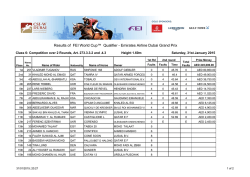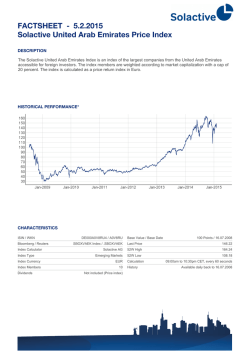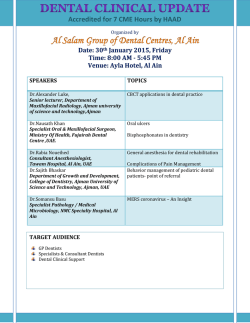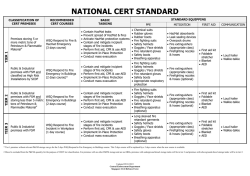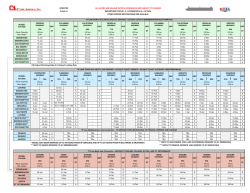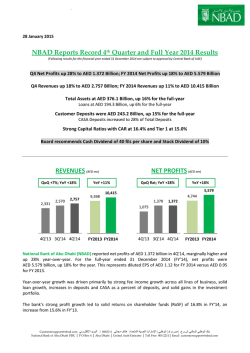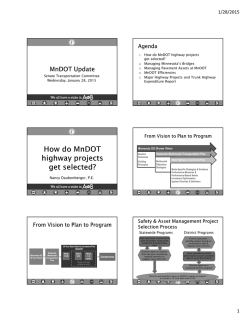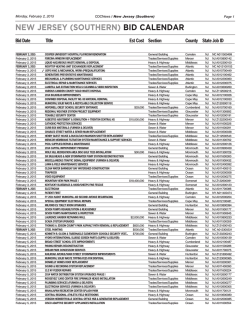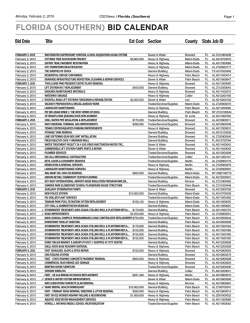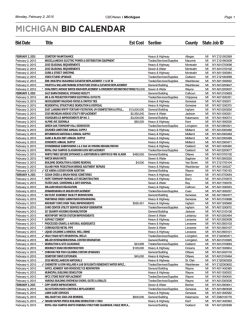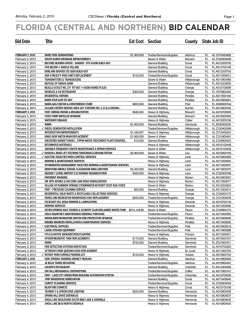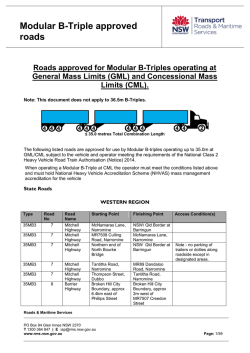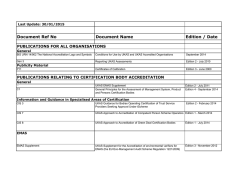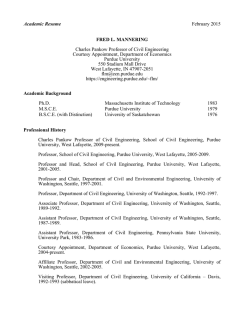
a letter from President and CEO Brian P. McGuire
AED Government Affairs Office 121 North Henry Street Alexandria, VA 22314 Telephone: 703.739.9513 Facsimile: 703.739.9488 January 28, 2015 The Honorable James Inhofe Chairman Environment & Public Works Committee 410 Dirksen Senate Office Building Washington, D.C. 20510 The Honorable Barbara Boxer Ranking Member Environment & Public Works Committee 456 Dirksen Senate Office Building Washington, D.C. 20510 AED URGES IMMEDIATE ACTION TO ENSURE THE HIGHWAY TRUST FUND’S LONG-TERM SOLVENCY Dear Chairman Inhofe & Ranking Member Boxer: I am writing on behalf of Associated Equipment Distributors (AED) to express our organization’s gratitude for holding this important hearing on surface transportation reauthorization and offer our support for a fully funded, multiyear highway bill. AED is the trade association representing distributors of construction, mining, energy, forestry, industrial, and agricultural equipment. A state-by-state listing of AED members is available at www.aedauthorized.com. The Highway Trust Fund (HTF) is rapidly approaching a breaking point. At the end of May, MAP-21, the current surface transportation authorization, will expire and the HTF will once again face insolvency. Gas taxes and other highway user fee revenues are insufficient to support even the current inadequate levels of transportation investment, let alone the additional construction needed to rebuild America’s crumbling infrastructure. Put simply--the federal highway program is in true jeopardy. The HTF’s dire situation puts highway and transit investment at risk, creates enormous uncertainty for transportation planners, and threatens economic growth. In fact, AED projects failure to act will jeopardize at least $2.4 billion in equipment market activity (i.e., dealer revenue from sales, rental, and product support) and close to four thousand equipment dealership jobs (see Appendix A for a state-by-state breakdown). The uncertainty surrounding the highway program continues to wreak havoc in construction markets. State transportation officials have had difficulty planning and contractors, with no clear sense of what their future business will be, have been reluctant to invest in new equipment. This has slowed recovery in our industry, which was hit as hard as any other during the recession and lost a third of its workforce. Restoring stability to federal transportation programs will help create and sustain millions of jobs. A 2013 study conducted by researchers at William & Mary's Thomas Jefferson Program in Public Policy found that the HTF deficit will amount to $365.5 billion by 2035. The AED report also proposed practical solutions: increasing the gas tax to 25 cents per gallon and indexing it for future inflation would raise $167 billion more than current baseline spending requirements over the next two decades. With fuel prices at record low levels, now is the time to increase highway program user fees. The positive impact on the economy of increased infrastructure investment will far outweigh any perceived negative effects. There is The association of leaders in equipment distribution AED Letter to Environment & Public Works Committee Leadership Urging Immediate Action to Ensure the Highway Trust Fund’s Long-Term Solvency January 28, 2015 Page 2 of 4 no better time to make bold decisions to position our country for long-term economic growth, job creation, competiveness, and security. We commend your efforts and look forward to working with you in a bipartisan manner to solve the nation’s infrastructure crisis. Sincerely, Brian P. McGuire President & CEO AED Letter to Environment & Public Works Committee Leadership Urging Immediate Action to Ensure the Highway Trust Fund’s Long-Term Solvency January 28, 2015 Page 3 of 4 Appendix A Equipment Market and Dealership Job Impact of Federal Highway Funding AED estimates that in FY 2014, the federal highway program will generate over $2.4 billion in equipment market activity (sales, rental, and product support) and sustain nearly 4,000 equipment dealership jobs. Those numbers do not include additional construction market activity supported by federal transit investment and state transportation construction activity induced by the federal program. The following table illustrates the core federal highway program’s state-by-state impact on the equipment industry. State 2014 Federal Highway Apportionment 1 (dollars) Equipment Market Impact 2 (dollars) Equipment Dealership Jobs Impact 3 Alabama 732,263,043 46,864,835 77 Alaska 483,955,039 30,973,122 51 Arizona 706,182,063 45,195,652 75 Arkansas 499,714,166 31,981,707 53 California 3,542,468,412 226,717,978 374 Colorado 516,112,989 33,031,231 55 Connecticut 484,770,705 31,025,325 51 Delaware 163,267,961 10,449,150 17 Dist. of Col. 154,002,708 9,856,173 16 Florida 1,828,689,002 117,036,096 193 Georgia 1,246,238,772 79,759,281 132 Hawaii 163,244,192 10,447,628 17 Idaho 276,061,294 17,667,923 29 Illinois 1,372,231,384 87,822,809 145 Indiana 919,668,926 58,858,811 97 Iowa 474,345,450 30,358,109 50 Kansas 364,737,489 23,343,199 39 Kentucky 641,292,458 41,042,717 68 Louisiana 677,413,014 43,354,433 72 Maine 178,165,560 11,402,596 19 Maryland 580,007,300 37,120,467 61 Massachusetts 586,191,765 37,516,273 62 FY 2014 Federal-Aid Highway Program Apportionments Under the Moving Ahead for Progress in the 21st Century Act, U.S. Department of Transportation Federal Highway Administration, Oct. 25, 2013 <http://www.fhwa.dot.gov/legsregs/directives/notices/n4510770t1.cfm>. Chart reflects apportioned total. 2 Derived by multiplying state highway apportionment by .064 based on finding by Dr. Stephen Fuller of George Mason University that each dollar in highway spending creates, on average, 6.4 cents in equipment market opportunity (defined as equipment sales, rental, and product support). 3 Derived by dividing equipment market opportunity by 605,943 based on 2013 AED Cost of Doing Business Report finding that the typical AED distributor averages $605,943 in sales per employee. 1 AED Letter to Environment & Public Works Committee Leadership Urging Immediate Action to Ensure the Highway Trust Fund’s Long-Term Solvency January 28, 2015 Page 4 of 4 Michigan 1,016,207,628 65,037,288 107 Minnesota 629,372,872 40,279,864 66 Mississippi 466,803,812 29,875,444 49 Missouri 913,719,741 58,478,063 97 Montana 396,007,464 25,344,478 42 Nebraska 278,976,662 17,854,506 29 Nevada 350,472,546 22,430,243 37 New Hampshire 159,469,843 10,206,070 17 New Jersey 963,682,664 61,675,690 102 New Mexico 354,439,590 22,684,134 37 New York 1,620,088,460 103,685,661 171 North Carolina 1,006,630,450 64,424,349 106 North Dakota 239,621,802 15,335,795 25 Ohio 1,293,739,008 82,799,297 137 Oklahoma 612,127,810 39,176,180 65 Oregon 482,423,497 30,875,104 51 Pennsylvania 1,583,603,275 101,350,610 167 Rhode Island 211,081,927 13,509,243 22 South Carolina 646,306,850 41,363,638 68 South Dakota 272,190,802 17,420,211 29 Tennessee 815,605,297 52,198,739 86 Texas 3,331,596,800 213,222,195 352 Utah 335,148,600 21,449,510 35 Vermont 195,886,832 12,536,757 21 Virginia 982,180,040 62,859,523 104 Washington 654,304,963 41,875,518 69 West Virginia 421,797,542 26,995,043 45 Wisconsin 726,226,908 46,478,522 77 Wyoming 247,262,623 15,824,808 26 Total 37,798,000,000 2,419,072,000 3,992
© Copyright 2025
